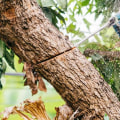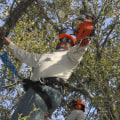Winter is often the best time to prune trees, as the lack of foliage makes it easier to spot and remove dead or diseased branches. Certified arborists should be consulted for large, mature trees, while smaller trees can be pruned with the help of long-reach tree clippers. Late winter and early spring are usually the best times to make adjustments to the shape of many trees and shrubs, as this is when they are in a dormant state. Pruning can help improve the shape, health and safety of trees, while also stimulating new growth and closing the wound caused by the pruning cut.
Dead, damaged or diseased branches should always be removed when first noticed, regardless of the time of year. It is important to identify potential hazards and obstacles, such as power lines, and use pruning techniques to encourage the tree to avoid them. Some trees, such as elm and oak, as well as those infected with fire blight, should be pruned in winter specifically to minimize the risk of spreading Dutch elm disease and oak wilt. Shrubs and trees that bloom on a new growth should be pruned in winter and early spring, while those that bloom on an old growth should be pruned in late spring or summer. Dead, damaged or diseased branches should always be removed when first noticed, regardless of the time of year. It is important to identify potential hazards and obstacles, such as power lines, and use pruning techniques to encourage the tree to avoid them. Some trees, such as elm and oak, as well as those infected with fire blight, should be pruned in winter specifically to minimize the risk of spreading Dutch elm disease and oak wilt. Shrubs and trees that bloom on a new growth should be pruned in winter and early spring, while those that bloom on an old growth should be pruned in late spring or summer.
Proper pruning can help promote the health, safety and beauty of your trees in the long term. Independent Tree is taking additional precautions in response to COVID-19.


